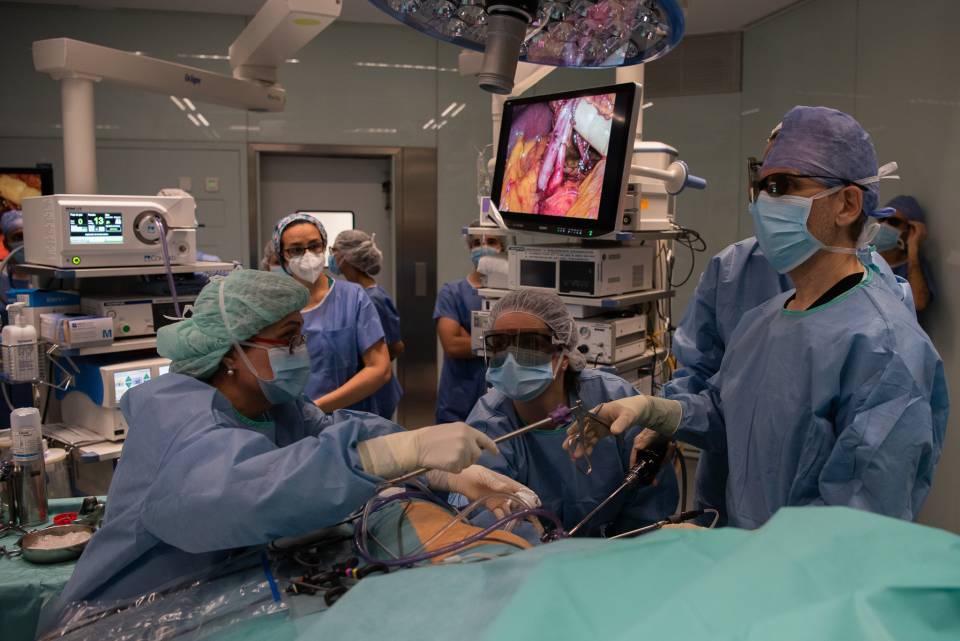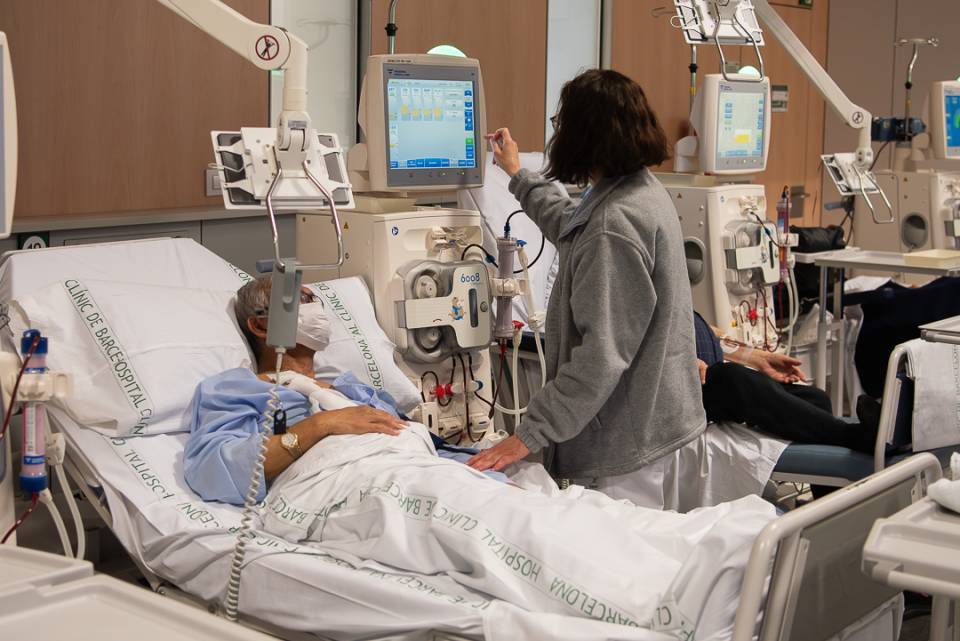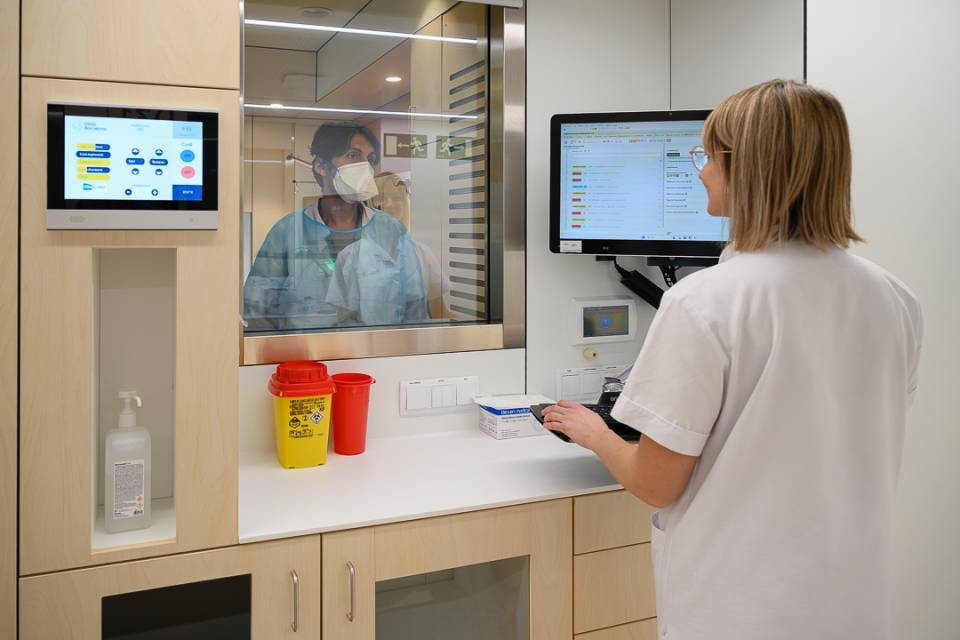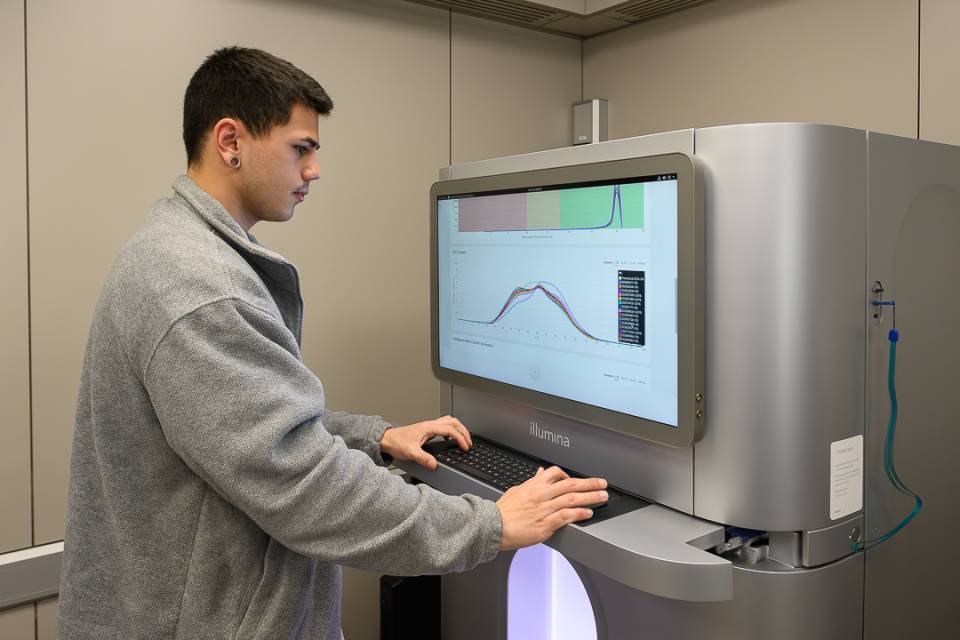The campaign and the 1,000 living donor kidney transplants at the Hospital Clínic were led by Dr. Josep Maria Campistol, director general, Dr. Antonio Alcaraz, head of the Urology Service, and Dr. Fritz Diekmann, head of the Kidney Transplant Unit. Beatriz Domínguez-Gil, general director of the National Transplant Organization (ONT) and Marc Ramentol , the asecretary general of health, also took part. Josep Milián and Nativitat Milián, two brothers who underwent a kidney transplant at the end of February, also participated in the presentation. Of the 5,000 kidney transplants carried out by the Hospital Clínic, 1,000 have been with a living donor. Of these 1,000, 110 were performed using robotic surgery. The Hospital Clínic has a living donor transplant programme, which is currently headed by Dr. Ignacio Revuelta.
The campaign presented today receives institutional support from the National Transplant Organization (ONT), the Catalan Transplant Organization-Department of Health (OCATT) and benefits from the collaboration of Novartis, Chiesi, Abex, Glycorex and ADER. The campaign was designed, produced and carried out thanks to the support and involvement of the creative agency, Wunderman Thompson, which is committed to working pro bono for this cause, in order to achieve a shared goal; to raise awareness about donation, to collaborate with science, and to help promote solidarity in society. .
Living donor kidney transplantation
A kidney transplant is a surgical procedure that involves a kidney obtained from a living or deceased donor being placed into a patient with terminal chronic kidney disease. The objective of the transplant is to re-establish the functions of the kidney, among other things, which cleanses toxins from the blood, regulates the fluid and electrolyte balance (balance between the amount of water and minerals), synthesizes hormones, and thus avoids the need for dialysis. In the case of a living donor transplant, the kidney comes from a healthy person (family member or friend), who voluntarily donates the organ to a loved one. Before the donation, various medical studies are carried out on the donor and the recipient in order to confirm the viability of the donation and their compatibility. Kidney translations are only performed on patients with kidney failure when the kidneys are no longer capable of performing their functions properly, which leads to an accumulation of water and waste products in the body.
Anyone wishing to be a living donor has to undergo a series of tests: a medical check-up, a complete blood count with serological tests and the determination of the prospective donor’s blood group, as well as imaging tests, in particular a CT angiogram, which allows doctors to study the anatomy of the kidneys.
In general, the left kidney is harvested for transplantation, because it has a longer renal vein, which facilitates the transplant surgery process... In cases in which there is a renal anomaly, the worse kidney is always removed. However, an organ with a single renal artery is preferred. Generally, the kidney consists of a renal artery that originates from the abdominal aorta. However, anatomic variations of the renal arteries occur, so the kidney sometimes has multiple arteries. The presence of multiple arteries or the harvesting of the right kidney should not be considered contraindications for donation. Laparoscopy is the surgical technique used for obtaining the donor’s kidney. It consists of making small incisions in the abdomen into which slender tubes (trocars) are inserted, and the surgical instruments are then guided through these tubes. Once the kidney has been dissected, vascular clips are applied to the artery and the renal vein, for the subsequent section. The organ is removed rapidly, and the donor’s blood is then flushed out by pumping a preservation solution through the renal artery.
The organ can be extracted either through an incision near the belly button or the lower abdomen or, in women, through an incision in the vaginal vault. Once this procedure has ended, the kidney is prepared in order to be transplanted immediately. On 110 occasions, the kidney was transplanted carried out using robotic surgery. The use of robotic surgery in kidney transplants has many advantages since, although it takes the same amount of time as open surgery, it minimises complications, avoids infections in the abdominal wall and the appearance of hernias, and favours a rapid recovery in the transplanted patient. Robotic surgery in this type of transplant has allowed minimally invasive surgery to be performed on patients who need it most; fragile patients with terminal renal failure.
“A thousand transplants, a thousand stories” campaign
This Thursday, the “A thousand transplants, a thousand stories” campaign was also launched, in order to raise public awareness about the benefits of living donation in patients with chronic renal failure. Several videos have been published, filmed in an operating theatre, of different donor/recipient pairs talking to the professionals who treated them. The campaign will be launched via various media outlets with advertisements in the press, radio, television, and in the Hospital Clínic metro station (Line 5). It will also be promoted on social media.
The following donor/recipient pairs appear in the campaign: (the videos of all the stories can be watched on www.miltrasplantamentsmilhistories.org.)
Case 963 – José Antonio Estevan (recipient) and Mercedes Travé (donor), a married couple, chat to Dr. Ignacio Revuelta. They were not compatible with one another, but a crossover transplant was performed. Mercedes expresses her great satisfaction at having given a kidney to someone who needed it and, at the same time, seeing how her husband's life has changed. Dr. Revuelta says that the donor can return to their normal life after the transplant. WATCH THE VIDEO.
Case 699 – Fede Oppenheimer (recipient) and Dr. Frederic Oppenheimer (donor), son and father, chat to Dr. Antonio Alcaraz. Dr. Oppenheimer was the head of the Hospital Clínic’s Kidney Transplant Unit when his son became ill. He confesses that he had to adapt to “speaking about the case that was his son”. Dr. Alcaraz affirms that, “the donor is God. They are the only one who must not be harmed”. WATCH THE VIDEO.
Case 639 – Diego Solana (recipient) and Javier Solana (donor), son and father, chat to Dr. Josep Maria Campistol. Diego had just turned 35 when he was diagnosed with kidney failure. Diego was scared to send his father to the operating theatre, despite being in perfect health. When Diego and Javier came round from the anaesthetic, the first thing they did was to ask about each other. Dr. Campistol maintains that the donor is a healthy person who has to continue to be healthy after the donation. WATCH THE VIDEO.
Case 637 – Òscar Agea (recipient) and Lluís Agea (donor), brothers, chat to Dr. Lluís Peri. Òscar, who has an additional disability, needed dialysis for 7.5 years. The brothers admit that the transplant has brought them even closer together. Òscar was able to have a daughter. “Nothing is impossible in life”, he says. Dr. Peri, meanwhile, confirms that the case of the Agea brothers was one of the most complex he has ever had. WATCH THE VIDEO.
Case 619 – Tomàs Cabello (recipient) and Servando Casas (donor), two friends, chat to Dr. Mireia Musquera. Tomàs needed dialysis for two years. Servando told him "if you need a kidney, I’ll give you one because I have two”. After the transplant, Servando, who is also the mayor of Mediona, performed the marriage ceremony between Tomàs and his wife. Dr. Musquera notes that, “the possibility of donation between friends is always very low”. WATCH THE VIDEO.
Case 587 – Anna Creus (recipient) and Marc Creus (donor), sister and brother, chat to Dr. Núria Esforzado. Anna had already had a transplant and was suffering due to the time required for dialysis and her state of health. Anna and Marc were on holiday in a town in Huesca and Anna asked him, “Would you give me a kidney?”. Marc says he is convinced this is the best thing he has done in his life. “I can live with one kidney, and she can start living again with my kidney”. WATCH THE VIDEO.
Case 510 – Pau Ibars (recipient) and Agustina Jané (donor), son and mother, chat to Dr. Fritz Diekmann. When Marc was diagnosed, Agustina did not hesitate for a second before offering him her kidney. Dr. Diekmann affirms that, “the donation of a kidney is a great act of love”. WATCH THE VIDEO.
Case 336 – Llanos Serna (recipient) and Carmen Serna (donor), sisters, chat to Dr. Álvarez-Vijande. Llanos was on a waiting list for many years, and had a lot of antibodies, which made it hard for her to have a transplant. Moreover, they had different blood groups. Llanos' other sisters might also have been compatible, and they tossed a coin to see who would end up donating a kidney. WATCH DE VIDEO.
1,000 living donor transplants at the Hospital Clínic:
Listed below is a brief chronology of the 1,000 living donor transplants performed at the Hospital Clínic de Barcelona.
- 1965 – 1st transplant. The first kidney transplant in Spain was performed at the Hospital Clínic. Dr. Josep M. Gil-Vernet’s team, with the collaboration of the nephrologist Antoni Caralps, performed the first successful kidney transplant in Spain in July 1965. The first living donor transplant was performed in October of that same year.
- 1971 – The first living donor transplant was performed on a child.
- 1977 – The first living donor transplant performed on a diabetic patient.
- 1978 – Living donor transplant number 100 was performed.
- 1999 – The first living donor transplant was performed between spouses.
- 2002 – The first laparoscopic nephrectomy was performed.
- 2006 – The first living donor transplant was performed between two incompatible patients (blood group).
- 2006 – The first living donor transplant performed on a patient aged over 70.
- 2009 – The first crossover living donor transplant was performed (with the Hospital Virgen de las Nieves- Sevilla).
- 2010 – Living donor transplant number 500 was performed.
- 2015 – The first living donor transplant using robotic surgery was performed.
- 2021 – Living donor transplant number 1,000 was performed.
As for the recipients, 36.6% were women and 63.5% men. The youngest patient was 8 years old and the oldest 77. With regard to the donors, 67.4% were women whilst 32.6% were men. The youngest donor was 18 and the oldest 84.




